Gemmingen Lower Castle
The lower castle in Gemmingen in the district of Heilbronn in northern Baden-Württemberg is the last of what were once three castles in the town that were built in the high Middle Ages as early mansions for the lords of Gemmingen . The castle was up in the first half of the 20th century connected with extensive land and is still owned by the family von Gemmingen.
history
The Gemmingen Lower Castle was the youngest of three high medieval castles in Gemmingen. The middle castle was the oldest and was occupied by Hans von Gemmingen as early as 1235. It was destroyed in the Thirty Years War and not rebuilt. The rent office is located in its place today . The upper castle was built around the middle of the 13th century, was no longer inhabited by the von Gemmingen family after 1630 and was sold to the Duchy of Württemberg. The Gemmingen town hall was later built in its place . The lower castle was built around 1274 by Schweiker von Gemmingen, known as Velscher . Originally it was a moated castle , which was rebuilt several times and whose moats were later filled. The oldest part of the castle is the hunger tower from the 13th century , which stands a little apart from the building .
The Velscher family line died out in 1552 with Hans von Gemmingen . He handed the castle over to Wolf von Gemmingen († 1555) in 1550 . His grandson Wolf Dietrich (1550–1595) had the palace renovated in the Renaissance style in 1592 . The ornate portal of the castle, the decorative bay window and the witch's tower with its spiral staircase on the building date from this time .
The castle remained in the possession of Wolf Dietrich's descendants for seven generations (tribe A, II. Line Gemmingen / Guttenberg, Gemmingen branch), even though the ownership structure within the family branch was fragmented from the end of the 18th century due to the division of inheritance.
When the Gemmingen church was rebuilt in 1846/47, numerous old epitaphs and grave slabs of the barons of Gemmingen were brought from the demolished old church to the palace, with the grave slabs being placed in the courtyard and garden of the palace. Although there have been several considerations since then to move the weather-prone stones back into the interior of the new church, the grave slabs have remained in the palace garden to the present day. In addition, other art treasures from the old Gemminger church came to the castle, including two altar wings in the style of Wolgemut .
In the early 20th century, half of the family estate belonged to Friedrich Pleikardt August Ludwig "Fritz" von Gemmingen (born April 7, 1863 in Karlsruhe ; † January 7, 1934 in Gemmingen). He was the son of Wilhelm Pleikard Ludwig von Gemmingen (1823-1903) and a royal Prussian first lieutenant, but his active military career ended after a serious injury sustained in a fall from a horse. In Rustschuk , where he was later deployed as port commander, he was looked after by the Bulgarian Raina Miltscheff, née. Geroff (1876–1955), whose first husband, the lawyer Konstantin Miltscheff, died in 1914. Fritz and Raina married on June 24, 1918 in Rustschuk and returned to Gemmingen after the war, where the couple lived in the lower castle together with Ernst von Gemmingen (1890–1970) and his wife . Ernst von Gemmingen belonged to the so-called Austrian branch of the family line, owned a quarter of the family property in Gemmingen, was corvette captain in the Dutch service and in the 1920s worked for a long time in the Dutch East Indies mapping the seas. During his absence from the Austrian branch of the family, Fritz had a power of attorney for Ernst's concerns. The remainder of the estate belonged to Ernst's uncle Reinhard Erich von Gemmingen (1866–1932).
Fritz von Gemmingen's nature is described as brittle, which earned him the nickname the frozen towel . Nevertheless, he was popular and respected in Gemmingen, where he actively participated in village life. On his 70th birthday, a large number of well-wishers appeared in the courtyard. His wife Raina, who lived a prestigious and expensive lifestyle, was completely different. Contrary to the regulations of the family entails, which provided Ernst as the heir to Fritz's property, Fritz gave his wife his property in his will. After his death, she sold numerous properties to the community of Gemmingen and to local farmers. The castle park adjacent to the castle, which the municipality later expanded into a public green area, was also sold. The municipality of Gemmingen named Rainastraße after her. In 1936 she sold extensive forest holdings to the city of Weinsberg .
After Raina's death in 1955, the remainder of the property came to her daughter Mara, who sold other formerly Gemmingen goods and granted the Gemmingen community a right of first refusal to purchase the castle. Mara died on July 14, 1962, probably as a result of a fire caused by a forgotten cigarette, in the castle in Gemmingen. Her sole heir was a young nephew from Bulgaria. The Bulgarian lock heirs have sold the remaining property. Parts of the castle furnishings ended up in the Munich art trade.
Finally, in 1957/58 the castle was sold to the Gemmingen community. Negotiations between the municipality of Gemmingen and Hans-Lothar von Gemmingen enabled Pleikard, Hansjörg and Albrecht von Gemmingen (from tribe B, III line Neckarzimmern / Bürg) to acquire the castle.
description
Originally it was a moated castle or a moated castle, but it was rebuilt many times and today no longer has the character of a castle. The moats were filled in and created as parking areas.
The main building of the castle is a two-storey, undivided plastered building on an almost square base. The lower two floors of the castle are made of solid stone, on which a third floor was built in half-timbered construction. The portal of the castle, which is dated to 1592 and has rich architectural decorations in the Renaissance style, is attributed to the sculptor Jakob Müller . The inscription on the portal reads: When one thousand five hundred years and ninety-two Zelendt was erected, this house was built with great diligence by Wolfgang Dietrich De Edlen of the high sex Vo Gemmingen and also the noble virtues of Mary, his consort with the name of her lineage Vo Gemmingen. From discipline and fear of God, his rhymes he leads: Whenever God wants, I am ready and my wife is my consolation equal to God, my consolation always and hope . The coat of arms on the portal is the Gemmingen-Gemmingen alliance coat of arms of the lord of the castle Wolf Dietrich von Gemmingen and his wife Maria von Gemmingen-Bürg († 1609).
A two-storey sandstone bay window is attached to the right corner, the window profiles of which refer to the same period of construction as the portal. The stair tower ( witch tower ) on the left side of the castle, which has a polygonal base and is designed as a round tower on the upper floor, is of the same age .
All rooms of the castle basement have late medieval ribbed vaults . In the oriel room the keystone of the vault shows the Gemmingen double coat of arms as above the portal.
The Hunger Tower , a round tower from the 13th century, goes back to the old castle complex. It was rebuilt according to a dating from 1520. The two-story tower has a domed vault on the upper floor. From there the fear hole leads to the basement, which was still used as a dungeon in the 19th century .
Historical tombs
Inside the castle, in the corridor of the basement, there is the historic tomb of the Palatinate-Neuburg councilor Johann von Gemmingen (1549–1599), which stood in the old Gemmingen church until the 19th century. The deceased is depicted life-size in armor, he has taken off his helmet and gloves and placed them on his right hand, his head is laid on a pillow and his hands are folded in prayer. The base is an inscription panel that names him and his life span, above and below the coats of arms of the parents and grandparents are shown as a test of nobility . The tomb once had additions to it, but these were probably lost when it was installed in the castle.
In the garden of the castle, 32 more grave slabs, once located in the old Gemminger church, as well as some fragments are set up. Except for the grave slab of the preacher Franciscus Irenicus († 1553), these are exclusively grave slabs of the von Gemmingen family. The oldest grave slab is that of Elisabeth von Mauer († 1354), wife of Dietrich the Elder († around 1374). In the following table the tombs are described in the order of their current position from left to right.
| image | description |
|---|---|
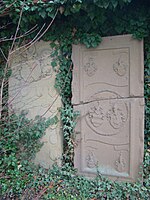 |
Left grave slab: Dietrich von Gemmingen († 1659) and his son Johann Dietrich († 1706). The plate shows an inscription panel surrounded by numerous small coats of arms and the large alliance coat of arms Gemmingen-Neipperg.
Right grave slab: Barbara von Mentzingen († 1617), wife of Philipp Dietrich von Gemmingen (1591 – after 1637), with Gemmingen-Mentzingen alliance coat of arms. |
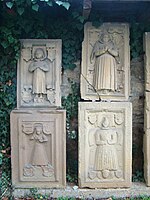 |
Four children's grave marks. The upper ones show the coats of arms of the Gemmingen and the Angelach, the lower left tomb shows the coats of arms of the Gemmingen and the Mentzingen, the lower right tomb shows the coats of arms of the Gemmingen and the Reischach above. |
 |
Maria von Gemmingen-Bürg († 1609), wife of Wolf Dietrich von Gemmingen-Gemmingen (1550–1595), with a Gemmingen-Gemmingen alliance coat of arms framed by a laurel wreath. |
 |
Philipp von Gemmingen zu Fürfeld († 1544), unadorned plate with a large Gemmingen coat of arms. |
 |
Children's grave, above the coats of arms of the Gemmingen and the Angelach. |
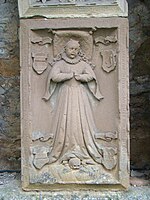 |
Children's grave, above the coats of arms of the Gemmingen and the Angelach. |
 |
Wolf Dietrich von Gemmingen (1550–1595), the cartouche board in the middle contains a pious saying, the coats of arms are those of Gemmingen and Schwarzenberg at the top, those of the Marschalk von Ostheim and Harrachcourt at the bottom. |
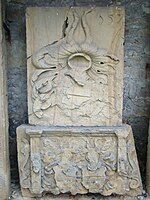 |
Fragments of tombs. |
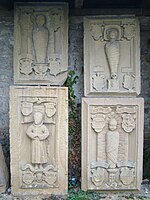 |
Four children's grave marks. The diapered children are Eberhard († 1616), Franz († 1594) and Rosine († 1593). |
 |
Johann Friedrich von Gemmingen (1571–1588), with an ornate family coat of arms in an oval, the coats of arms in the corners are those of Gemmingen and Neipperg at the top, those of the Marschalk von Ostheim and Hirschhorn at the bottom. |
 |
Dietrich von Gemmingen (1526–1587), with an ornate family coat of arms in an oval and four small coats of arms in the corners, above those of the Gemmingen and the Marschalk von Ostheim. |
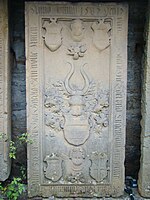 |
Rosina von Gemmingen (1552–1587), daughter of Dietrich von Gemmingen (1526–1587). The coats of arms in the corners are those of Gemmingen, Schwarzberg, Marschalk von Ostheim and Harrachcourt. |
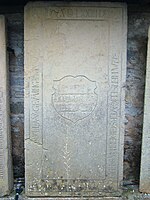 |
Sibylla von Gemmingen († 1574), unadorned plate with a large Gemmingen coat of arms. |
 |
Franciscus Irenicus (1495–1553), preacher and director of the Gemmingen Latin School . |
 |
Wolf von Gemmingen († 1555), the coats of arms in the corners are those of Gemmingen, Dalberg, Steinach and Harrachcourt (?). |
 |
Philippa von Schwarzberg († 1554), first wife of Dietrich von Gemmingen (1526–1587). |
 |
Philipp von Gemmingen, called Schellig († 1520), with the family coat of arms under Gothic tracery ornamentation. |
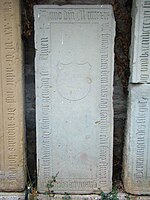 |
Anna von Gemmingen born von Helmstatt († 1519), wife of Philipp von Gemmingen, known as Schellig († 1520), unadorned plate with the Helmstatt's coat of arms that can hardly be recognized. At the top left of the shield you can just make out the raven's beak. |
 |
Plycker (Pleikard) von Gemmingen († 1515), unadorned grave slab with the Gemmingen coat of arms. |
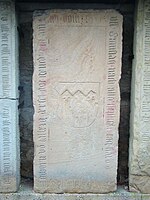 |
Anna von Dalberg († 1503), wife of Pleikard von Gemmingen († 1515), unadorned plate with a large coat of arms of Dalberg. |
 |
Eberhard von Gemmingen († 1490), with a large Gemmingen coat of arms with a crest. |
 |
Metza von Gemmingen († 1485), the middle field shows the outline of a lady praying the rosary, whose head can no longer be seen. |
 |
Gravestone for Konrad von Gemmingen († 1463) and his son Dieter , who died in 1482 , with a large Gemmingen coat of arms with a crest. |
 |
Oechelhäuser read the year of death 1404 on the grave slab of a Diether that was damaged in the area of the year of death, but according to the sequence of the early bearers of the lead name Dieter / Diether / Dietrich it can only be Dietrich von Gemmingen († 1414). The large coat of arms was once held by a dog, which can only be seen in fragments. |
 |
Grave slab with a large coat of arms of the Sickingen. According to Oechelhäuser, it is about the grave slab of Margaretha von Sickingen († 1507), who was married to Konrad von Gemmingen. He refers to Stocker, where neither such a Margaretha von Sickingen nor a Konrad von Gemmingen is mentioned in the quoted passage. |
 |
Grave slab of Elisabeth von Mauer († 1354), wife of Dietrich the Elder of Gemmingen , with a large coat of arms of the Lords of Mauer. Oldest grave slab in the palace gardens. |
Individual evidence
- ↑ Heitland 1991, pp. 43/44.
- ↑ Fekete 2002, p. 167.
- ↑ Heitland 1991, pp. 43/44.
- ↑ Kopp 2000, p. 70.
- ↑ Kopp 2000, p. 70.
- ↑ Oechelhäuser 1909, pp. 173/174.
- ↑ Heitland 1991, pp. 45-50.
- ↑ Heitland 1991, pp. 47/48.
- ↑ Heitland 1991, p. 48.
- ↑ Heitland 1991, p. 45.
- ↑ Heitland 1991, pp. 44/45.
- ↑ Fekete 2002, p. 167.
- ↑ Oechelhäuser 1909, p. 177 and illus. P. 176.
- ↑ Determination of the tombstones according to Oechelhäuser 1909, pp. 177–180. There are still two Rococo tombs with putti for Friedrich Jacob von Gemmingen († 1783) and his wife Clara Friderica Greck von Kochendorf († 1787) mentioned, which are no longer in the palace gardens today. Oechelhäuser could not read one of the plates, it is probably the grave plate of the preacher Irenicus. In addition, Oechelhäuser only lists six children's grave marks, while there are ten today.
- ↑ Anneliese Seeliger-Zeiss: The grave slab of Franciscus Irenicus in Gemmingen , in: Ettlinger Hefte 29 , 1995, pp. 43–46.
- ^ Carl Wilhelm Friedrich Ludwig Stocker : Family Chronicle of the Barons of Gemmingen , Heidelberg 1895, p. 63.
literature
- Adolf von Oechelhäuser (Ed.): The art monuments of the Grand Duchy of Baden (Volume 8.1): The art monuments of the districts of Sinsheim, Eppingen and Wiesloch (Heidelberg district), Tübingen 1909, pp. 173-180.
- Walter von Hueck: Lineage of the Barons von Gemmingen , special print from the Genealogical Handbook of the Adels Volume 37 (Freiherrliche Häuser A, Volume VI), CA Starke Verlag, Limburg an der Lahn 1966
- Maria Heitland: Family chronicle of the barons of Gemmingen. Continuation of the chronicles from 1895 and 1925/26 , Elztal 1991.
- Ulrich Kopp: The Kraichgaugemeinde Gemmingen - A site inspection at the turn of the millennium , Gemmingen 2000.
- Julius Fekete: Art and cultural monuments in the city and district of Heilbronn , Theiss-Verlag, Stuttgart 2002, p. 167/168.
Web links
Coordinates: 49 ° 9 '22.1 " N , 8 ° 58' 55.9" E






